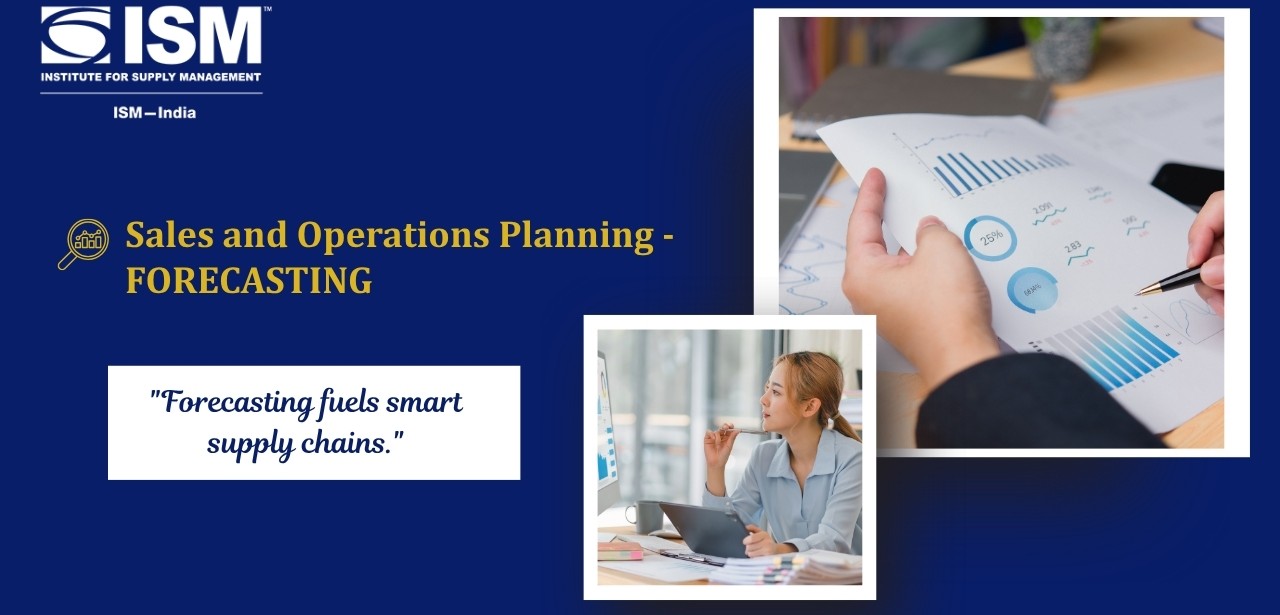 Sales and Operations Planning – Forecasting
Sales and Operations Planning – Forecasting
Laying the Foundation for Smarter, Leaner, and More Agile Supply Chains
In a world of shifting consumer demands, supply chain disruptions, and rising service expectations, organizations cannot afford to plan reactively. Forecasting, when embedded within an effective Sales and Operations Planning (S&OP) framework, acts as a strategic tool to navigate uncertainty and drive performance across the value chain.
S&OP brings together diverse functions—sales, marketing, finance, operations, and procurement—to create a unified, forward-looking plan. At the core of this alignment lies forecasting, the process of predicting future demand to support balanced and informed decision-making.
 Why Forecasting is the Backbone of S&OP
Why Forecasting is the Backbone of S&OP
Forecasting goes beyond numbers. It helps create a shared understanding of demand, enabling synchronized planning across departments. Here’s why it’s critical:
 Informed Decision-Making Forecasts guide essential business activities—from purchasing raw materials to scheduling production and managing inventory.
Informed Decision-Making Forecasts guide essential business activities—from purchasing raw materials to scheduling production and managing inventory. Cost Optimization Accurate demand projections prevent overproduction, reduce inventory holding costs, and minimize waste, leading to a leaner supply chain.
Cost Optimization Accurate demand projections prevent overproduction, reduce inventory holding costs, and minimize waste, leading to a leaner supply chain. Enhanced Customer Service Forecast-driven planning ensures that businesses are ready to fulfill customer demand with the right product at the right time.
Enhanced Customer Service Forecast-driven planning ensures that businesses are ready to fulfill customer demand with the right product at the right time. Strategic Visibility Forecasting helps leadership teams visualize market trends and make proactive strategic choices rather than reactive fixes.
Strategic Visibility Forecasting helps leadership teams visualize market trends and make proactive strategic choices rather than reactive fixes. Forecasting Methods: Choosing the Right Tool for the Task
Forecasting Methods: Choosing the Right Tool for the Task
Successful forecasting involves selecting the appropriate method based on the product type, lifecycle stage, and business context. Common forecasting methods include:
 Qualitative Techniques
Qualitative Techniques
- Market research
- Executive judgment
- Delphi method
- Sales force input
These are especially useful when historical data is limited or when launching new products.
 Quantitative Techniques
Quantitative Techniques
- Moving averages
- Exponential smoothing
- Linear regression
- Time-series models
These methods rely on historical data and are ideal for products with stable and consistent demand.
 Collaborative Forecasting
Collaborative Forecasting
- Involves suppliers, distributors, and key partners
- Enhances accuracy through shared insights and transparency
- Forms the foundation of CPFR (Collaborative Planning, Forecasting, and Replenishment)
 Forecast Accuracy – Measuring What Matters
Forecast Accuracy – Measuring What Matters
Forecasting isn’t a one-time task—it’s a continuous improvement process. Businesses must consistently evaluate accuracy using metrics such as:
- MAD (Mean Absolute Deviation): Measures average forecast error
- MAPE (Mean Absolute Percentage Error): Expresses error as a percentage for easier comparison
- Tracking Signal: Detects bias in forecasting models and helps adjust strategies accordingly
Forecast performance review is critical in adjusting assumptions, refining models, and maintaining agility in a changing business environment.
 Responsive Forecasting – Adapting to Change
Responsive Forecasting – Adapting to Change
A robust forecasting process remains dynamic. It must accommodate variables such as:
- Seasonal demand patterns
- Market promotions or price changes
- Competitor activity
- Supplier lead time fluctuations
- New product introductions or end-of-life phases
- Shifts in economic conditions or customer preferences
Flexibility and scenario-based planning ensure that businesses can respond quickly to unexpected disruptions or opportunities.
 Forecasting as a Cross-Functional Enabler
Forecasting as a Cross-Functional Enabler
One of the biggest value-adds of forecasting is that it drives alignment across teams. It becomes the common language between sales, operations, marketing, procurement, and finance.
When done right, forecasting:
- Bridges short-term execution and long-term strategy
- Connects supply chain operations with business goals
- Creates a culture of shared accountability and data-driven collaboration
 Final Thought
Final Thought
Forecasting in the S&OP process isn’t just about predicting the future—it’s about preparing for it intelligently. Organizations that prioritize integrated, accurate, and collaborative forecasting systems are better equipped to:
- Serve their customers
- Manage their inventory
- Control their costs
- Navigate supply chain complexity with confidence
In today’s fast-paced market environment, forecasting is no longer a back-end task. It’s a strategic lever that can make or break operational success.


 Got a lot of insight
Got a lot of insight